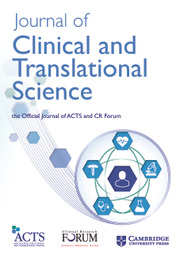No CrossRef data available.
Article contents
539 Charting the metabolic biogeography of the colorectum in cancer: Challenging the right-sided versus left-sided classification
Published online by Cambridge University Press: 11 April 2025
Abstract
Objectives/Goals: Colorectal cancer (CRC) is classified into right-sided, left-sided, and rectal cancer. Clinicopathological and molecular features vary along the colorectum, even within subsites, leading to inconsistencies in identifying relevant biomarkers. We created a CRC metabolome map to explore diagnostic and survival heterogeneity across subsites. Methods/Study Population: A total of 372 patient-matched tumor and normal tissue samples were collected from seven colorectal subsites: cecum (n = 63), ascending colon (n = 44), transverse colon (n = 32), descending colon (n = 28), sigmoid colon (n = 75), rectosigmoid colon (n = 38), and rectum (n = 92). Liquid chromatography–mass spectrometry was used to compare metabolite abundances. Cox proportional hazards regression assessed metabolite impact on survival, adjusted for clinical covariates. Parametric and nonparametric tests were applied to compare the metabolite abundances. An interactive, publicly accessible online platform was developed to allow researchers to explore and generate hypotheses from this data. Results/Anticipated Results: Our study identified 39 and 70 significantly altered metabolites, including bile acids and lysophosphatidylcholines, across tumors and normal mucosa, showing metabolic heterogeneity between CRC subsites. We observed significant linear trends in metabolite gradients from the cecum to the rectum, and it was depended on the disease status. Comparison of tumors to patient-matched normal mucosa revealed metabolite changes exclusive to each subsite. Metabolite differences correlated with survival were unique to each subsite. Additionally, we developed an interactive, publicly accessible CRC metabolome database to share this valuable resource: https://colorectal-cancer-metabolome.com/yale-university. Discussion/Significance of Impact: This study provides the first CRC metabolome map, revealing metabolic differences across colorectal subsites. It challenges the right vs. left CRC classification, highlighting subsite-specific biomarker identification. Findings offer insights for personalized treatments tailored to the tumor type to improve patient outcomes.
Information
- Type
- Precision Medicine/Health
- Information
- Creative Commons
- This is an Open Access article, distributed under the terms of the Creative Commons Attribution-NonCommercial-NoDerivatives licence (https://creativecommons.org/licenses/by-nc-nd/4.0/), which permits non-commercial re-use, distribution, and reproduction in any medium, provided the original work is unaltered and is properly cited. The written permission of Cambridge University Press must be obtained for commercial re-use or in order to create a derivative work.
- Copyright
- © The Author(s), 2025. The Association for Clinical and Translational Science

